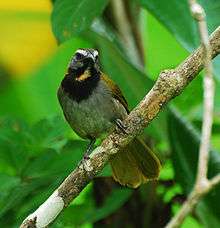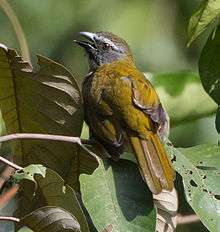Buff-throated saltator
| Buff-throated saltator | |
|---|---|
 | |
| Scientific classification | |
| Kingdom: | Animalia |
| Phylum: | Chordata |
| Class: | Aves |
| Order: | Passeriformes |
| Family: | see text |
| Genus: | Saltator |
| Species: | S. maximus |
| Binomial name | |
| Saltator maximus (Muller, 1776) | |
The buff-throated saltator (Saltator maximus) is a seed-eating bird. Traditionally placed in the cardinal family (Cardinalidae), it actually seems to be closer to the tanagers (Thraupidae).[2] It breeds from southeastern Mexico to western Ecuador and northeastern Brazil.
This is the type species of Saltator. Consequently, it and its closest allies would retain the genus name when this apparently polyphyletic group[2] is eventually split up.
The buff-throated saltator is on average 20 cm (7.9 in) long and weighs 42–52 g (1.5–1.8 oz). The adult has a slate-grey head with a white supercilium and a greenish crown. The upperparts are olive green, the underparts are grey becoming buff on the lower belly, and the throat is buff, edged with black. The thick convex bill and legs are black. Young birds are duller, and have a white-mottled blackish throat and breast, and brown markings on the lower underparts.
The common call is a high seeeer. Males duet melodiously with a warbled cheery cheery answered by cheery to you.
This is a species of dense vegetation. The buff-throated saltator feeds on fruit (e.g. of Cymbopetalum mayanum (Annonaceae), Trophis racemosa (Moraceae), and gumbo-limbo (Bursera simaruba)),[3] buds, nectar and slow-moving insects. It forages at low and mid levels, sometimes with mixed species flocks.
The two pale blue eggs per clutch measure some 22–32 mm (0.87–1.26 in) long by about 16.5–21.5 mm (0.65–0.85 in) wide and weigh about 4.8–6.1 g (0.17–0.22 oz) each, which is large among Saltator eggs.[4] They are laid in a bulky cup nest up to 2 m (6.6 ft) high in a tree or bush.

References
- ↑ BirdLife International (2012). "Saltator maximus". IUCN Red List of Threatened Species. Version 2013.2. International Union for Conservation of Nature. Retrieved 26 November 2013.
- 1 2 See the genus article for details
- ↑ Foster, Mercedes S. (2007). "The potential of fruiting trees to enhance converted habitats for migrating birds in southern Mexico". Bird Conservation International. BirdLife International. 17 (1): 45–61. doi:10.1017/S0959270906000554.
- ↑ Echeverry-Galvis, María Ángela; Córdoba-Córdoba, Sergio (2006). "Descripción del huevo del saltátor collarejo (Saltator cinctus) y comentarios preliminares sobre huevos del género Saltator" [Description of the egg of the Masked Saltator (S. cinctus) and preliminary comments on the eggs of the genus Saltator] (PDF). Boletín de la Sociedad Antioqueña de Ornitología (in Spanish). 16 (1): 76–84.
- Hilty, Steven L. (2003). Birds of Venezuela. Princeton University Press. ISBN 0-7136-6418-5.
- Stiles, F. Gary; Skutch, Alexander F. (1989). A Guide to the Birds of Costa Rica. Comstock Publishing Associates. ISBN 0-8014-9600-4.
External links
| Wikimedia Commons has media related to Saltator maximus. |
| Wikispecies has information related to: Saltator maximus |
- "Buff-throated Saltator media". Internet Bird Collection.
- Buff-throated Saltator photo gallery at VIREO (Drexel University)
- Buff-throated Saltator species account at NeotropicalBirds (Cornell University)
